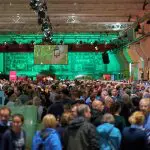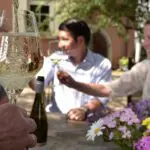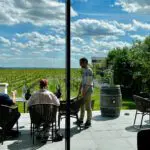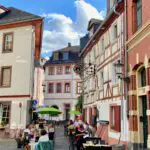…the – uh – Nahe what? The Nahe – try pronouncing ‘Nar-huh?’ – is a small river meandering South of the Mosel, in the state of Rhinania-Palatinate. It meets the River Rhine just at the Southern entrance to the romantic Rhine Valley. The wine area surrounding the river is called… Nahe! Same as for Mosel, Mittelrhein or Ahr, the name of the wine area is borrowed from the river that flows in-between.

Though wine has been planted here since Roman times, the Nahe has never managed to claim fame such as Mosel or Rheingau have done. Few cities, little industry and just a little too close to the most famous wine regions… there is not much else to this region besides wine, agriculture and some of the most enchanting nature in Germany.
Even today, amongst German wineophiles, this gem keeps flying under the wine-radar. Much to the disadvantage of many winemakers – but much to the advantage of wine lovers seeking to discover special places. It is insiders who know about the beauty of the area – and wine lovers who know about the fabulous wines of the region… Though some estates like Schlossgut Diel, or Weingut Dönnhoff have made it to international fame, and are ranked amongst the best in Germany.
But then there are many more winemakers producing excellent quality – the wine guide Gault Millau (the – though not undisputed or unchallenged – authority in the German wine business) lists about 59 winemakers. And not only Rieslings they offer. While Riesling makes for roughly 30% of the output of the area, don’t miss out on the Pinot Gris’ and Pinot Blancs. Still, it is the Rieslings that get oenophiles to salivate. International wine critic Stuart Pigott recently compared the just released 2016 Grand Cru Rieslings of the Nahe to the best white wines in France, attributing them lots of character, freshness and vitality.
Still if you are lucky enough to taste and compare the best Nahe Rieslings horizontally (as we did at a recent VDP event) – you will discover a huge width in range of aromas and taste. Not only are the vineyards of the area geographically very diverse, the winemakers are putting in a huge energy to create wines reflecting the best of every single terroir.
There’s no better way to understand the wines from the Nahe than by tasting them where they have been made: with a trip to the winemaker’s estates; with a picnic on top of the vineyards; and stops in local restaurants and taverns. Your wine tour will take you past rolling hills, historic bridges, secluded river bents, wines on steepest slopes (as in can-not-walk-steep), some of the steepest cliffs North of the Alps, and through villages that once belonged to Bavaria, France, and Prussia (not in a chronological order, more per who just had won the last battle).
You’d have to take a stop at Weingut Hermannsberg, one of the German 100 must-visit wine places, and enjoy their fab Rieslings paired with sweeping sights of the Nahe Valley. Also, you’d want to stay overnight in historic Meisenheim with its gorgeous old town.
While you should count at least a full day, the great news is: Visits to Nahe wine region can be graciously combined with stops in Rheingau, Rheinhessen or Mittelrhein – there no reason to forfeit a classic for this secret tip.
Feel free to contact us for travel tips, a tailored wine itinerary or a guided tour.









